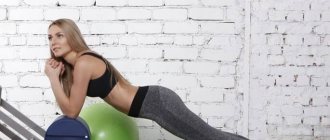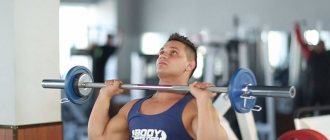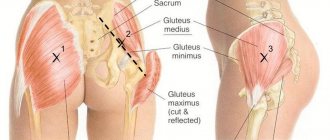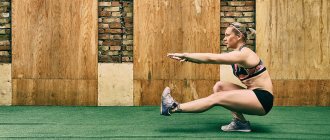The plank exercise is very popular in fitness. It is very simple, can be done at home, and at the same time incredibly effective. Another advantage of the plank is its versatility - it is suitable for both men and women, both beginners in sports and professionals, especially considering the numerous types of planks in sports that allow you to shift the load on certain muscle groups, achieving the desired results. Let's look at what types of exercises you can use.
Plank
The elbow stand is often called a plank. All professional athletes can perform it, as well as those who do yoga and other types of physical exercise. Elbowstand is considered one of the main exercises for developing and strengthening the abdominals, back and core.
It is intended not only for these groups, but also has a beneficial effect on the upper shoulder girdle, strengthening this area.
During the exercise, a person may feel strong tension in the abs, back, joints and shoulders. At the same time, the static position allows you to pump up these groups without extra effort.
You can learn to do it even after giving birth, three to four months later, when other exercises are still prohibited. During an elbow stand, the following muscle groups work:
- delta - anterior and upper;
- rear delta;
- core muscles;
- abdominal muscles;
- gastrocnemius;
- quadriceps;
- buttocks.
The main load is placed on the abdominal muscles and back muscles, but many other areas are also involved during the exercise. Additionally, the load can be increased by using weights or other special devices during the exercise.
If you apply the pose daily, each time slightly increasing the time interval, you can achieve strong abs within a month of starting classes.
Newbie mistakes
Most often, those who do not perform the side plank correctly cannot stay in the pose. Let's look at the most common mistakes made by novice athletes, which also happen to professionals:
- Bent, hunched back. In this position, it is difficult to maintain balance, your back quickly begins to hurt and it is difficult to breathe.
- Incorrect hand position. If the hand is placed at a different angle than necessary, there will be a risk of injury to the joints of the hand, the inability to perform the exercise, and improper load on the body.
- Sagging of the pelvis during fixation. If the buttocks are not tense, the movement will not be possible, since these muscles are the main ones for performing the plank.
- Head down. A chin lowered toward the chest makes breathing difficult and creates unnecessary stress on the neck muscles.
- Relaxed or bent knees. Due to this position of the legs, proper execution of the exercise will be impossible.
How to learn to do a plank
It doesn't take long to learn how to stand on your elbows. This exercise is quite easy and in most cases even children can do it.
The plank can be not only horizontal, but also vertical. The elbow stand can be performed in different positions, but in order to learn how to do a vertical one, you must first learn to assume a horizontal body position.
The technique seems quite easy at first glance, but not everyone can learn and try to get into it the first time.
First, the person must take a lying position on the floor, then place the elbow joints under the shoulder joints and focus on them. The legs are positioned shoulder-width apart on half toes. After a person learns to maintain a standing position on the floor in a horizontal position, it will be possible to proceed directly to performing an elbow stand in a vertical position.
There are different types of plank:
- classical;
- on straight arms;
- with raised hand;
- with a raised leg;
- with two limbs raised at the same time;
- in a jump;
- with resistance;
- on fitball;
- lateral;
- varieties of lateral;
- inverted.
Each type can be combined with each other. In this case, various muscle groups will be additionally involved. You can supplement the bar with various weights, dumbbells and a body bar.
Classic elbow plank for strong abs: how to do it correctly
The classic plank can be performed in various ways. The easiest thing to learn is to stand on your elbows and legs in a certain position. To do this, you should focus on the floor on your elbow joints and toes, maintaining the position of your body for some time.
To begin with, you can try holding the plank for 30 seconds, then you will need to increase the interval as you strengthen your abs and back.
You can begin to alternate between lifting one arm and one leg, gradually changing positions and supporting the body weight with just two or three limbs.
Body position is a very important rule during the exercise. If a person has scoliosis, it will be difficult for him to take a perfectly straight position and learn, so you can ask your partner to adjust the position at first.
When should you make an exercise more difficult?
The reverse plank, like any exercise, ceases to be difficult over time. In other words, your muscles get used to this position and no longer perceive such a load. At one point you realize that it is very easy for you to complete the plank. And then it makes sense to think about complicating the initial exercise.
For this, for example, you can use various weighting agents. Alternatively, you can put a metal “pancake” from the barbell. When lifting your body, you will feel some discomfort. It will be much more difficult to climb with such a load. Consequently, your load on all muscle groups will increase.
You can also transfer your body weight from four supports to three. To do this, lift one leg up. If you want to make this exercise more difficult, put weights or special weights on your raised leg.
In addition, it is quite possible to shift your body weight from a flat floor to a hill. To perform such a plank, you can raise your hands on the step platform. If it is cumulative, then gradually the number of additional sections that will lift you higher can be increased.
What muscles work
During a stand, a person uses almost all of his muscles. Mainly during the position, the muscles of the core, abs, deltas are involved - the upper, middle and lower calf muscles and back muscles.
The back muscles are completely strengthened, using both the upper and lower sections, including the lower back. The abs are also used during elbow stands, including the obliques. The arms hold the weight of the whole body, so they actively strengthen during exercise.
The legs bear a significant part of the load during the plank, so not only the calf muscles are involved, but also the muscles of the thighs and buttocks. By using the rack as often as possible, you can strengthen the buttocks area and make them more toned. In this case, you can change the position of your legs, making them wider or narrower, as well as alternately raising and lowering them. In this case, they will strengthen more actively. It is believed that the plank allows you to get rid of the initial manifestations of cellulite in a short period of time.
Benefit
Due to the fact that all muscle groups are loaded, blood flow accelerates, organs and their systems are saturated with oxygen, and the overall tone of the body increases significantly. This is where the benefits of the “Reverse Plank” exercise come into play. If you do it regularly, you can achieve good success. Thanks to the exercise you can:
- reduce the thickness of the fat layer in one of the most problematic areas - the lower abdomen;
- strengthen the upper abs, muscles of the upper limbs;
- improve body flexibility;
- increase the tone of the spinal muscles;
- maintain correct posture.
In general, the “Reverse Plank” exercise makes it possible to get rid of excess weight, stop pathological changes that cause severe pain in the lumbar area, and also correct posture.
Correct elbow stand technique
Especially at first, when a person wants to learn, special attention should be paid to a perfectly straight back. You should learn to avoid arching your lower back so as not to harm your spine. If a person has problems with the spine, you should consult a doctor to give the go-ahead or prohibition to perform an inverted plank.
In order to stand on your elbows correctly, you need to have fairly strong arms and shoulder girdle. It is important to remember that the main impact is on the abs, back and upper shoulder girdle, so with weak limbs it will be difficult for a person to learn to hold his body in an inverted position for a long time. To do this, you should first strengthen your arms using a classic horizontal bar.
It is also important to perform the stance so that the toes are extended and the feet can be connected.
With this position, it will be easier to support your own body weight and you will be able to avoid unpleasant sensations. For a more aesthetic plank look, people try to keep their legs perfectly straight, but for a more simplified version, you can bend your legs and spread them to the sides. In this case, it will be even easier to maintain body weight.
Recommendations
- It has been proven that if a person simply counts to himself while doing the plank, he will do more on the side that is stronger. Therefore, download a stopwatch to your phone so as not to overload one side of your body;
- Use a long gym mat to avoid slipping. You can put an additional mat under your elbow;
- Try not to break the angles, so that the humerus is perpendicular to the floor and the elbow remains strictly under the shoulder;
- Don't do the plank with your shoulder to your ear;
- The trapezius should remain relaxed, and you should not squeeze your neck during the exercise.
Plank as a guarantee of health
During elbow stand training, a person will feel tension not only in the elbow joints, which are directly involved in the position, but also the muscles of the abdominals, core, back and arms are actively involved in the position.
The plank has a positive effect on the following factors:
- improves digestion;
- promotes fat burning in the abdomen and thighs;
- strengthens arms, back and abs;
- improves well-being;
- improves the circulation of positive energy and relieves blood stagnation.
The plank can be performed daily, each time gradually increasing the interval at which a person is able to hold the position. In this case, the result will be more effective.
Adviсe
- There is no need to exercise if your muscles hurt or you feel tense. Pain is especially common in the abdominal muscles if they have not recovered. You should give them some more time to regenerate, and then train the muscles further.
- Be sure to drink water during exercise. Fluid plays a huge role both in the functioning of the body and in training. Abdominal training will be much more effective if you consume enough fluid during training.
- It is necessary to monitor your breathing while performing the side plank. This exercise engages the muscles close to the diaphragm, so it is very important to breathe correctly. You should maintain a moderate breathing rate, do not increase it and do not retain air in yourself.
- You should stop doing the plank if you don’t have enough strength to hold it with good technique. There is an opinion that you can neglect the latter in order to spend more time in the plank. This is a misconception, because, as mentioned earlier, maintaining the correct technique is an important factor in training.
Plank: contraindications
Like any physical exercise, planks and elbow stands have their contraindications. Among them:
- pregnancy and recovery period after childbirth;
- children under 3 years of age;
- diseases of the elbow joints;
- diseases of internal organs;
- oncological diseases;
- disorders in the vertebral discs;
- neck problems.
In addition, inverted elbow stands should be avoided during colds and viral diseases, otitis media, headaches and menstruation.
People who play sports often start trying to perform various tricks with their body. Those who practice yoga usually know how to perform a variety of types of handstands and headstands, as well as classic versions of the plank from the most basic. Standing in a plank allows you to get rid of many pathological conditions, and also significantly strengthens the abdominal press.











